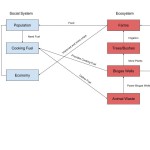The core idea behind my diagram is to show how with the introduction of the Biogas Wells, the Indian people are able to use the resources that are more readily available to them (such as cow manure) to provide themselves with a cleaner and more efficient way of cooking, as well as improve their farming. Like the video, I also show how the slurry produced by the biogas wells is mixed into compost so that it may be used by farms. This in turn allows the farms to produce improved crops as well as more of them. These crops can then be sold at market where the population may purchase them, and the cycle repeats. I think one key aspect of the Biogas Wells is how it made the process of cooking not only cleaner, but it improved the cycle overall by making it more efficient.
Compared to the diagram in “What is Human Ecology,” the two diagrams share similar traits under both types of systems. Mine does not include the need for child labor, since I based it off of how the system would be after the Biogas Wells were introduced. My diagram includes an Economy section under the Social System, since the farmers were able to sell more crops due to the slurry compost mix produced by the Biogas Wells. One thing that I think we can learn from my diagram is that due to the increased amount of crops produced, the population is able to purchase more of them. 

Hello Tim
My name is Justin, wrote my diagram to show how switching to the biogas stoves would improve health and education in the population. I found it interesting how we both found the cyclic nature of transfer of goods and service between society and the ecosystem of our diagrams and the one from the article.